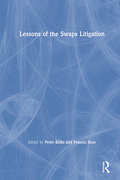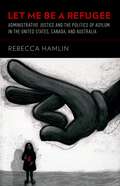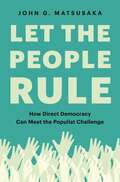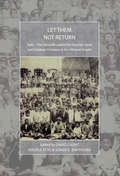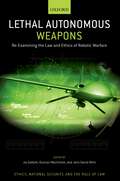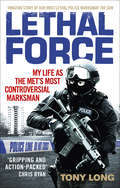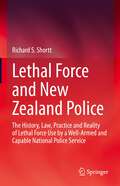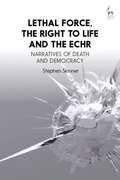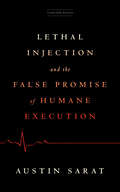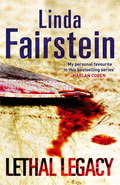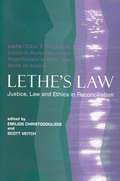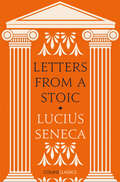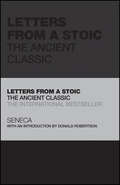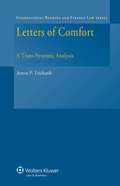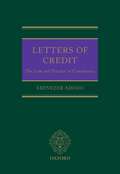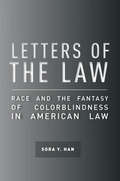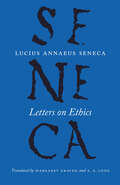- Table View
- List View
Lessons of the Swaps Litigation
by Peter Birks Francis RoseThis is the first comprehensive review of the extent of remedies and impact of contractual agreements on restitution claims for void, unenforceable, and discharged contracts.
Lessons of the Swaps Litigation
by Peter Birks and Francis RoseThis is the first comprehensive review of the extent of remedies and impact of contractual agreements on restitution claims for void, unenforceable, and discharged contracts.
Let Me Be a Refugee: Administrative Justice and the Politics of Asylum in the United States, Canada, and Australia
by Rebecca HamlinInternational law provides states with a common definition of a "refugee" as well as guidelines outlining how asylum claims should be decided. Yet even across nations with many commonalities, the processes of determining refugee status look strikingly different. This book compares the refugee status determination (RSD) regimes of three popular asylum seeker destinations: the United States, Canada, and Australia. Though they exhibit similarly high levels of political resistance to accepting asylum seekers, refugees access three very different systems-none of which are totally restrictive or expansive-once across their borders. These differences are significant both in terms of asylum seekers' experience of the process and in terms of their likelihood of being designated as refugees. Based on a multi-method analysis of all three countries, including a year of fieldwork with in-depth interviews of policy-makers and asylum-seeker advocates, observations of refugee status determination hearings, and a large-scale case analysis, Rebecca Hamlin finds that cross-national differences have less to do with political debates over admission and border control policy than with how insulated administrative decision-making is from either political interference or judicial review. Administrative justice is conceptualized and organized differently in every state, and so states vary in how they draw the line between refugee and non-refugee.
Let the People Rule: How Direct Democracy Can Meet the Populist Challenge
by John G. MatsusakaHow referendums can diffuse populist tensions by putting power back into the hands of the peoplePropelled by the belief that government has slipped out of the hands of ordinary citizens, a surging wave of populism is destabilizing democracies around the world. As John Matsusaka reveals in Let the People Rule, this belief is based in fact. Over the past century, while democratic governments have become more efficient, they have also become more disconnected from the people they purport to represent. The solution Matsusaka advances is familiar but surprisingly underused: direct democracy, in the form of referendums. While this might seem like a dangerous idea post-Brexit, there is a great deal of evidence that, with careful design and thoughtful implementation, referendums can help bridge the growing gulf between the government and the people.Drawing on examples from around the world, Matsusaka shows how direct democracy can bring policies back in line with the will of the people (and provide other benefits, like curbing corruption). Taking lessons from failed processes like Brexit, he also describes what issues are best suited to referendums and how they should be designed, and he tackles questions that have long vexed direct democracy: can voters be trusted to choose reasonable policies, and can minority rights survive majority decisions? The result is one of the most comprehensive examinations of direct democracy to date—coupled with concrete, nonpartisan proposals for how countries can make the most of the powerful tools that referendums offer.With a crisis of representation hobbling democracies across the globe, Let the People Rule offers important new ideas about the crucial role the referendum can play in the future of government.
Let Them Not Return: Sayfo – The Genocide Against the Assyrian, Syriac, and Chaldean Christians in the Ottoman Empire (War and Genocide #26)
by David GauntThe mass killing of Ottoman Armenians is today widely recognized, both within and outside scholarly circles, as an act of genocide. What is less well known, however, is that it took place within a broader context of Ottoman violence against minority groups during and after the First World War. Among those populations decimated were the indigenous Christian Assyrians (also known as Syriacs or Chaldeans) who lived in the borderlands of present-day Turkey, Iran, and Iraq. This volume is the first scholarly edited collection focused on the Assyrian genocide, or “Sayfo” (literally, “sword” in Aramaic), presenting historical, psychological, anthropological, and political perspectives that shed much-needed light on a neglected historical atrocity.
Lethal Autonomous Weapons: Re-Examining the Law and Ethics of Robotic Warfare (Ethics, National Security, and the Rule of Law)
by Jai Galliott, Duncan MacIntosh, Jens David OhlinThe question of whether new rules or regulations are required to govern, restrict, or even prohibit the use of autonomous weapon systems has been the subject of debate for the better part of a decade. Despite the claims of advocacy groups, the way ahead remains unclear since the international community has yet to agree on a specific definition of Lethal Autonomous Weapon Systems and the great powers have largely refused to support an effective ban. In this vacuum, the public has been presented with a heavily one-sided view of Killer Robots. This volume presents a more nuanced approach to autonomous weapon systems that recognizes the need to progress beyond a discourse framed by the Terminator and HAL 9000. Re-shaping the discussion around this emerging military innovation requires a new line of thought and a willingness to challenge the orthodoxy. Lethal Autonomous Weapons focuses on exploring the moral and legal issues associated with the design, development and deployment of lethal autonomous weapons. In this volume, we bring together some of the most prominent academics and academic-practitioners in the lethal autonomous weapons space and seek to return some balance to the debate. As part of this effort, we recognize that society needs to invest in hard conversations that tackle the ethics, morality, and law of these new digital technologies and understand the human role in their creation and operation.
Lethal Autonomous Weapons: Re-Examining the Law and Ethics of Robotic Warfare (Ethics, National Security, and the Rule of Law)
The question of whether new rules or regulations are required to govern, restrict, or even prohibit the use of autonomous weapon systems has been the subject of debate for the better part of a decade. Despite the claims of advocacy groups, the way ahead remains unclear since the international community has yet to agree on a specific definition of Lethal Autonomous Weapon Systems and the great powers have largely refused to support an effective ban. In this vacuum, the public has been presented with a heavily one-sided view of Killer Robots. This volume presents a more nuanced approach to autonomous weapon systems that recognizes the need to progress beyond a discourse framed by the Terminator and HAL 9000. Re-shaping the discussion around this emerging military innovation requires a new line of thought and a willingness to challenge the orthodoxy. Lethal Autonomous Weapons focuses on exploring the moral and legal issues associated with the design, development and deployment of lethal autonomous weapons. In this volume, we bring together some of the most prominent academics and academic-practitioners in the lethal autonomous weapons space and seek to return some balance to the debate. As part of this effort, we recognize that society needs to invest in hard conversations that tackle the ethics, morality, and law of these new digital technologies and understand the human role in their creation and operation.
Lethal Force: My Life As the Met’s Most Controversial Marksman
by Tony LongTony Long was the best ‘shot’ the Met ever had. Under the codename ‘Echo 7’, he was ‘licenced to kill’ bringing down scores of targets, sometimes with deadly force. In 1985 he opened fire on a suspect to save a four-year-old girl whose mother had been stabbed to death by her assailant. Two years later he was involved in another high profile shooting while confronting three armed criminals. On both occasions Tony was commended by the Metropolitan Police Commissioner. But in the spring of 2005, coming face to face with suspected drug dealer and armed robber Azelle Rodney, a volley of point blank shots would bring his career crashing to an end, tarnish his reputation and leave him fighting a murder charge and possible life sentence. From life or death cases and botched operations to political fallouts, this book charts the controversial career from rookie seventies beat cop to Long's command of SO19 – the Met’s most elite specialist firearms unit. Long’s personal testimony and professional insight raises serious issues about the duties, pressures and responsibilities that fall on the shoulders of those we task to risk their lives, and take the lives of others, in our name.
Lethal Force and New Zealand Police: The History, Law, Practice and Reality of Lethal Force Use by a Well-Armed and Capable National Police Service
by Richard S. ShorttThis book challenges the notion that the New Zealand Police are one of only four global police services that does not have routinely armed officers, using arguments and facts drawn from 2000 to 2019, a period of important change for the organisation and its relationship with firearms, particularly following the outrages of the Christchurch mosques terrorist massacres in 2019, and the 2020 shooting death of a young police constable in Aotearoa New Zealand. This book provides a brief history of the Police from its beginnings to the present day with a specific focus on its relationship with firearms, which contextualize the law that justifies use of lethal force in a country that has abolished the death penalty. It examines police policies, procedures, training and structures governing deployment and use of firearms in Aotearoa New Zealand, and the independent oversight that now applies to fatal and non-fatal shootings by Police. Using 43 publicly released oversight agency reports and data directly related to police shootings, such as who is being shot, this book investigates how the police are using lethal force, who is being affected, and what this might mean for the service with regards to the operational deployment of firearms and the potential for use of lethal force within the community into the future.
Lethal Force, the Right to Life and the ECHR: Narratives of Death and Democracy
by Stephen SkinnerIn its case law on the use of lethal and potentially lethal force, the European Court of Human Rights declares a fundamental connection between the right to life in Article 2 of the European Convention on Human Rights and democratic society. This book discusses how that connection can be understood by using narrative theory to explore Article 2 law's specificities and its deeper historical, social and political significance. Focusing on the domestic policing and law enforcement context, the book draws on an extensive analysis of case law from 1995 to 2017. It shows how the connection with democratic society in Article 2's substantive and procedural dimensions underlines the right to life's problematic duality, as an expression of a basic value demanding a high level of protection and a contextually limited provision allowing states leeway in the use of force. Emphasising the need to identify clear standards in the interpretation and application of the right to life, the book argues that Article 2 law's narrative dimensions bring to light its core purposes and values. These are to extract meaning from pain and death, ground democratic society's foundational distinction between acceptable force and unacceptable violence, and indicate democratic society's essential attributes as a restrained, responsible and reflective system.
Lethal Force, the Right to Life and the ECHR: Narratives of Death and Democracy
by Stephen SkinnerIn its case law on the use of lethal and potentially lethal force, the European Court of Human Rights declares a fundamental connection between the right to life in Article 2 of the European Convention on Human Rights and democratic society. This book discusses how that connection can be understood by using narrative theory to explore Article 2 law's specificities and its deeper historical, social and political significance. Focusing on the domestic policing and law enforcement context, the book draws on an extensive analysis of case law from 1995 to 2017. It shows how the connection with democratic society in Article 2's substantive and procedural dimensions underlines the right to life's problematic duality, as an expression of a basic value demanding a high level of protection and a contextually limited provision allowing states leeway in the use of force. Emphasising the need to identify clear standards in the interpretation and application of the right to life, the book argues that Article 2 law's narrative dimensions bring to light its core purposes and values. These are to extract meaning from pain and death, ground democratic society's foundational distinction between acceptable force and unacceptable violence, and indicate democratic society's essential attributes as a restrained, responsible and reflective system.
Lethal Injection and the False Promise of Humane Execution
by Austin SaratWith a history marked by incompetence, political maneuvering, and secrecy, America's "most humane" execution method is anything but. From the beginning of the Republic, this country has struggled to reconcile its use of capital punishment with the Constitution's prohibition of cruel punishment. Death penalty proponents argue both that it is justifiable as a response to particularly heinous crimes, and that it serves to deter others from committing them in the future. However, since the earliest executions, abolitionists have fought against this state-sanctioned killing, arguing, among other things, that the methods of execution have frequently been just as gruesome as the crimes meriting their use. Lethal injection was first introduced in order to quell such objections, but, as Austin Sarat shows in this brief history, its supporters' commitment to painless and humane death has never been certain. This book tells the story of lethal injection's earliest iterations in the United States, starting with New York state's rejection of that execution method almost a century and half ago. Sarat recounts lethal injection's return in the late 1970s, and offers novel and insightful scrutiny of the new drug protocols that went into effect between 2010 and 2020. Drawing on rare data, he makes the case that lethal injections during this time only became more unreliable, inefficient, and more frequently botched. Beyond his stirring narrative history, Sarat mounts a comprehensive condemnation of the state-level maneuvering in response to such mishaps, whereby death penalty states adopted secrecy statutes and adjusted their execution protocols to make it harder to identify and observe lethal injection's flaws. What was once touted as America's most humane execution method is now its most unreliable one. What was once a model of efficiency in the grim business of state killing is now marked by mayhem. The book concludes by critically examining the place of lethal injection, and the death penalty writ large, today.
Lethal Legacy (Alexandra Cooper #11)
by Linda FairsteinWhen Assistant District Attorney Alexandra Cooper is summoned to Tina Barr's apartment on Manhattan's Upper East Side, she finds a neighbour convinced that the young woman has been assaulted. But the terrified victim, a conservator of rare books and maps, denies that and refuses to co-operate with Alex and the police investigators. Tina disappears, and then another woman is found murdered in the same apartment, with an extremely valuable book at her side. The book has probably been stolen, but from whom and how? Pursuing the murderer Alex is drawn into the strange and privileged world of rich and secretive book collectors, where avarice and greed is as strong an inheritance as wealth..In a beguiling mix and history and suspense Linda Fairstein takes readers on a breath-taking ride through collections of beautiful first editions, supposedly 'lost' atlases, and deep into the hidden rooms and tunnels of the great New York Public Library.
Lethe's Law: Justice, Law and Ethics in Reconciliation
by Emilios Christodoulidis Scott VeitchThis book offers a series of original essays by an international group of scholars whose work looks comparatively at law's attempts to deal with the past. Ranging from questions of criminal responsibility and amnesty to those of law's relation to time,memory, and the ethics of reconciliation, it is a sustained jurisprudential and philosophical analysis of one of the most important and pressing legal concerns of our time.Among its key concerns is that justice's demand on law has changed and, in the face of a divided and violent past, law is being called on to do the kind of work it ordinarily shuns. What this means for conventional understandings of law, as well as for the relation between law and politics in times of transition, is explored through a discussion of experiences from Eastern Europe and Germany, to South Africa, Israel, and Australia.The book thus provides a timely investigation of the nature of law and legal institutions in times of political and social change, and will appeal to a broad international audience including lawyers, political theorists, criminologists, and philosophers.
Letters from a Stoic: Volume Iii (Collins Classics)
by Lucius SenecaHarperCollins is proud to present its incredible range of best-loved, essential classics.
Letters from a Stoic: The Ancient Classic (Capstone Classics)
by Seneca Donald RobertsonDISCOVER THE ENDURING LEGACY OF ANCIENT STOICISM Since Roman antiquity, Lucius Annaeus Seneca’s Letters have been one of the greatest expressions of Stoic philosophy. In a highly accessible and timeless way, Seneca reveals the importance of cultivating virtue and the fleeting nature of time, and how being clear sighted about death allows us to live a life of meaning and contentment. Letters from a Stoic continues to fascinate and inspire new generations of readers, including those interested in mindfulness and psychological techniques for well-being. This deluxe hardback selected edition includes Seneca’s first 65 letters from the Richard M. Gummere translation. An insightful introduction by Donald Robertson traces Seneca’s busy life at the centre of Roman power, explores how he reconciled his Stoic outlook with vast personal wealth, and highlights Seneca’s relevance for the modern reader.
Letters of Comfort: A Trans-Systemic Analysis (International Banking and Finance Law Series #15)
by Anton P. TrichardtThis book presents the first thoroughgoing analysis of the contractual effect of letters of comfort as it appears in both common law and civil law systems. The commentary draws on cases from a wide variety of jurisdictions and on the full range of legal scholarship on the subject in several languages. Among the specific issues and topics raised along the way are the following: the typology of letters of comfort; the legal nature of letters of comfort; the use of letters of comfort in corporate group and banking practice; the economic explanation for the use of letters of comfort; the contractual effect of letters of comfort in French law; ‘ten commandments’ of letters of comfort; Clearly evoking the tension between business needs, the law, and judicial application, the book analyses what happens when the relationship between a lender and a creditor breaks down, or the latter becomes insolvent, and courts or arbitrators are asked to determine the legal status of a comfort letter. This is an area of practice in which lawyers in any field of business activity are inevitably concerned, and in which useful guidance is scarce. For this reason this detailed analysis will be very welcome.
Letters of Credit: The Law and Practice of Compliance
by Ebenezer AdodoThis book examines the legal nature and requirements of compliance in letter of credit transactions in Anglo-American jurisdictions, as well as the associated contract choice of law issues. It gives an authoritative exposition of the mechanics of the law on the problem of compliance in the field, and is the first to afford a comprehensive, highly analytical critique of the topic from the point of view of modern international banking practice. In a user-friendly style, it provides an in-depth elucidation of the context of the key roles of individual parties during the course of the transactions, aiding a thorough understanding of the legal problems covered. Structured in four parts, it covers the opening of a complying letter of credit; the regularity of performance under a properly opened letter of credit; ways in which an unreimbursed bank may recover money it mistakenly paid against a faulty presentation; and the conflict of laws problems involved in the context of a beneficiary claiming entitlement to the sum on the credit against an allegedly complying tender of documents. In the conflict of laws section substantial attention is given to the many difficult hurdles that the potential claimant often confronts, and explores the various methods and techniques available. An important aspect of the analysis in this part is ascertainment of the legal system which the courts at common law and under Rome I Regulation would apply to resolve a claim.
Letters of the Law: Race and the Fantasy of Colorblindness in American Law (The Cultural Lives of Law)
by Sora Y. HanOne of the hallmark features of the post–civil rights United States is the reign of colorblindness over national conversations about race and law. But how, precisely, should we understand this notion of colorblindness in the face of enduring racial hierarchy in American society? In Letters of the Law, Sora Y. Han argues that colorblindness is a foundational fantasy of law that not only informs individual and collective ideas of race, but also structures the imaginative capacities of American legal interpretation. Han develops a critique of colorblindness by deconstructing the law's central doctrines on due process, citizenship, equality, punishment and individual liberty, in order to expose how racial slavery and the ongoing struggle for abolition continue to haunt the law's reliance on the fantasy of colorblindness. Letters of the Law provides highly original readings of iconic Supreme Court cases on racial inequality—spanning Japanese internment to affirmative action, policing to prisoner rights, Jim Crow segregation to sexual freedom. Han's analysis provides readers with new perspectives on many urgent social issues of our time, including mass incarceration, educational segregation, state intrusions on privacy, and neoliberal investments in citizenship. But more importantly, Han compels readers to reconsider how the diverse legacies of civil rights reform archived in American law might be rewritten as a heterogeneous practice of black freedom struggle.
Letters on Ethics: To Lucilius (The Complete Works of Lucius Annaeus Seneca)
by Lucius Annaeus SenecaThe Roman statesman and philosopher Seneca (4 BCE–65 CE) recorded his moral philosophy and reflections on life as a highly original kind of correspondence. Letters on Ethics includes vivid descriptions of town and country life in Nero’s Italy, discussions of poetry and oratory, and philosophical training for Seneca’s friend Lucilius. This volume, the first complete English translation in nearly a century, makes the Letters more accessible than ever before. Written as much for a general audience as for Lucilius, these engaging letters offer advice on how to deal with everything from nosy neighbors to sickness, pain, and death. Seneca uses the informal format of the letter to present the central ideas of Stoicism, for centuries the most influential philosophical system in the Mediterranean world. His lively and at times humorous expositions have made the Letters his most popular work and an enduring classic. Including an introduction and explanatory notes by Margaret Graver and A. A. Long, this authoritative edition will captivate a new generation of readers.
Letters on Ethics: To Lucilius (The Complete Works of Lucius Annaeus Seneca)
by Lucius Annaeus SenecaThe Roman statesman and philosopher Seneca (4 BCE–65 CE) recorded his moral philosophy and reflections on life as a highly original kind of correspondence. Letters on Ethics includes vivid descriptions of town and country life in Nero’s Italy, discussions of poetry and oratory, and philosophical training for Seneca’s friend Lucilius. This volume, the first complete English translation in nearly a century, makes the Letters more accessible than ever before. Written as much for a general audience as for Lucilius, these engaging letters offer advice on how to deal with everything from nosy neighbors to sickness, pain, and death. Seneca uses the informal format of the letter to present the central ideas of Stoicism, for centuries the most influential philosophical system in the Mediterranean world. His lively and at times humorous expositions have made the Letters his most popular work and an enduring classic. Including an introduction and explanatory notes by Margaret Graver and A. A. Long, this authoritative edition will captivate a new generation of readers.
Letters on Ethics: To Lucilius (The Complete Works of Lucius Annaeus Seneca)
by Lucius SenecaThe Roman statesman and philosopher Seneca (4 BCE–65 CE) recorded his moral philosophy and reflections on life as a highly original kind of correspondence. Letters on Ethics includes vivid descriptions of town and country life in Nero’s Italy, discussions of poetry and oratory, and philosophical training for Seneca’s friend Lucilius. This volume, the first complete English translation in nearly a century, makes the Letters more accessible than ever before. Written as much for a general audience as for Lucilius, these engaging letters offer advice on how to deal with everything from nosy neighbors to sickness, pain, and death. Seneca uses the informal format of the letter to present the central ideas of Stoicism, for centuries the most influential philosophical system in the Mediterranean world. His lively and at times humorous expositions have made the Letters his most popular work and an enduring classic. Including an introduction and explanatory notes by Margaret Graver and A. A. Long, this authoritative edition will captivate a new generation of readers.
Letters on Ethics: To Lucilius (The Complete Works of Lucius Annaeus Seneca)
by Lucius Annaeus SenecaThe Roman statesman and philosopher Seneca (4 BCE–65 CE) recorded his moral philosophy and reflections on life as a highly original kind of correspondence. Letters on Ethics includes vivid descriptions of town and country life in Nero’s Italy, discussions of poetry and oratory, and philosophical training for Seneca’s friend Lucilius. This volume, the first complete English translation in nearly a century, makes the Letters more accessible than ever before. Written as much for a general audience as for Lucilius, these engaging letters offer advice on how to deal with everything from nosy neighbors to sickness, pain, and death. Seneca uses the informal format of the letter to present the central ideas of Stoicism, for centuries the most influential philosophical system in the Mediterranean world. His lively and at times humorous expositions have made the Letters his most popular work and an enduring classic. Including an introduction and explanatory notes by Margaret Graver and A. A. Long, this authoritative edition will captivate a new generation of readers.
Letters on Ethics: To Lucilius (The Complete Works of Lucius Annaeus Seneca)
by Lucius Annaeus SenecaThe Roman statesman and philosopher Seneca (4 BCE–65 CE) recorded his moral philosophy and reflections on life as a highly original kind of correspondence. Letters on Ethics includes vivid descriptions of town and country life in Nero’s Italy, discussions of poetry and oratory, and philosophical training for Seneca’s friend Lucilius. This volume, the first complete English translation in nearly a century, makes the Letters more accessible than ever before. Written as much for a general audience as for Lucilius, these engaging letters offer advice on how to deal with everything from nosy neighbors to sickness, pain, and death. Seneca uses the informal format of the letter to present the central ideas of Stoicism, for centuries the most influential philosophical system in the Mediterranean world. His lively and at times humorous expositions have made the Letters his most popular work and an enduring classic. Including an introduction and explanatory notes by Margaret Graver and A. A. Long, this authoritative edition will captivate a new generation of readers.
Letters on Ethics: To Lucilius (The Complete Works of Lucius Annaeus Seneca)
by Lucius Annaeus SenecaThe Roman statesman and philosopher Seneca (4 BCE–65 CE) recorded his moral philosophy and reflections on life as a highly original kind of correspondence. Letters on Ethics includes vivid descriptions of town and country life in Nero’s Italy, discussions of poetry and oratory, and philosophical training for Seneca’s friend Lucilius. This volume, the first complete English translation in nearly a century, makes the Letters more accessible than ever before. Written as much for a general audience as for Lucilius, these engaging letters offer advice on how to deal with everything from nosy neighbors to sickness, pain, and death. Seneca uses the informal format of the letter to present the central ideas of Stoicism, for centuries the most influential philosophical system in the Mediterranean world. His lively and at times humorous expositions have made the Letters his most popular work and an enduring classic. Including an introduction and explanatory notes by Margaret Graver and A. A. Long, this authoritative edition will captivate a new generation of readers.
